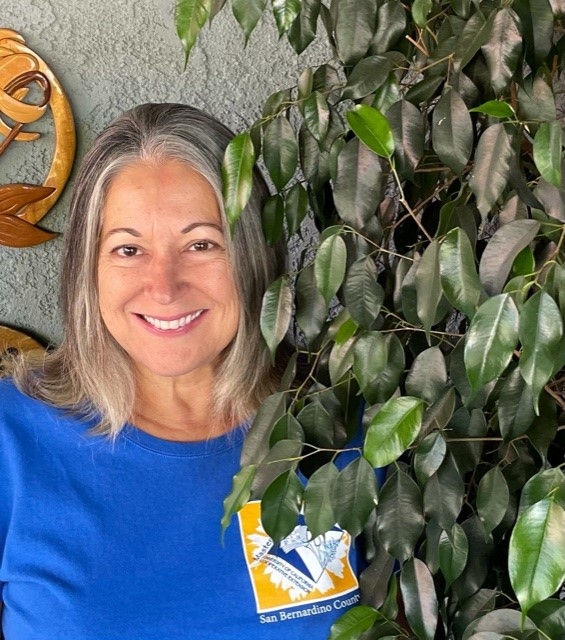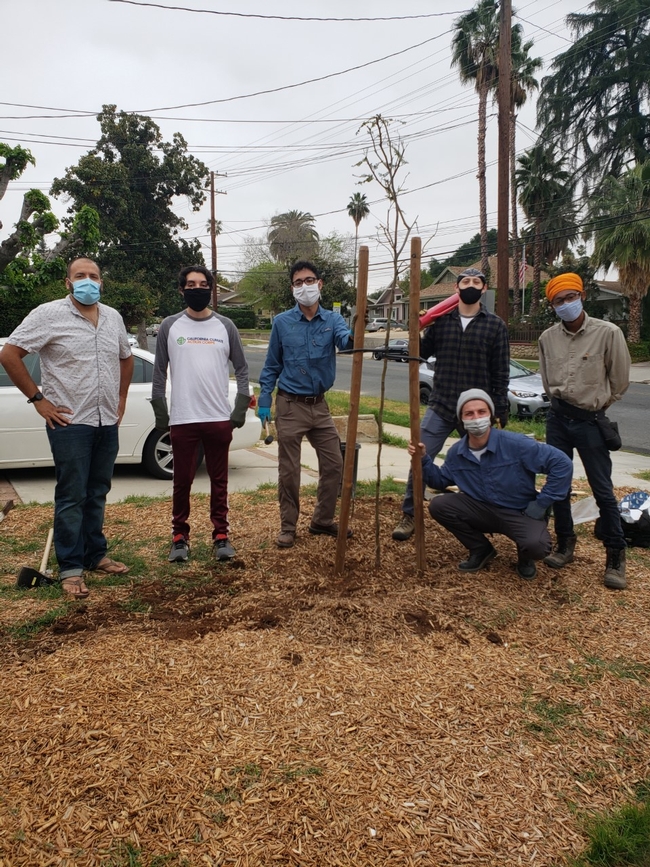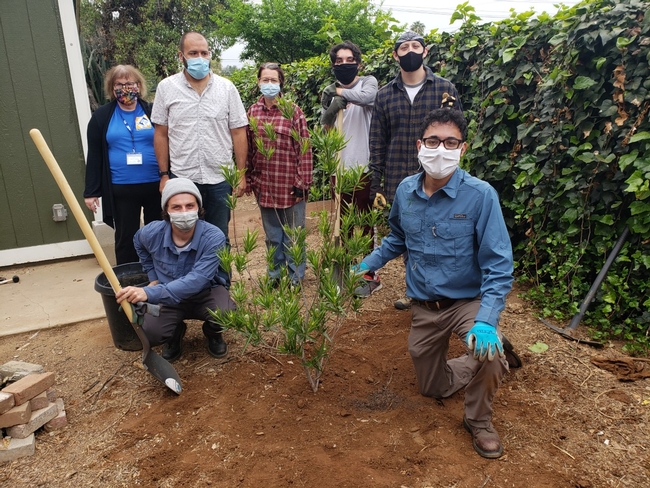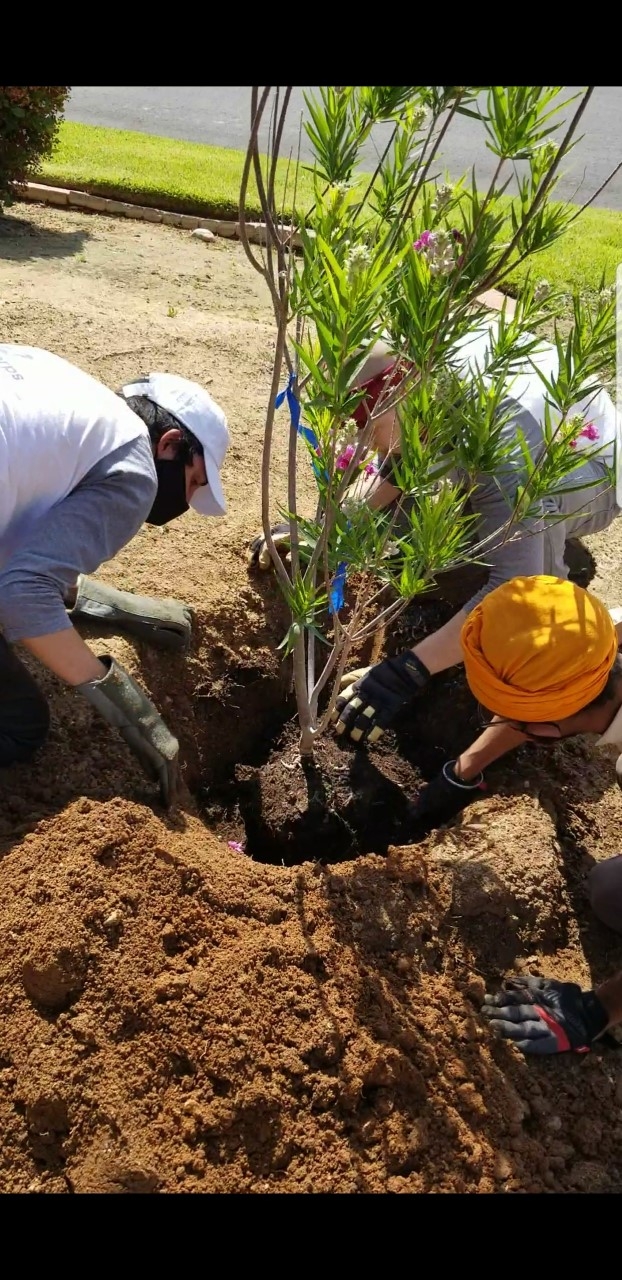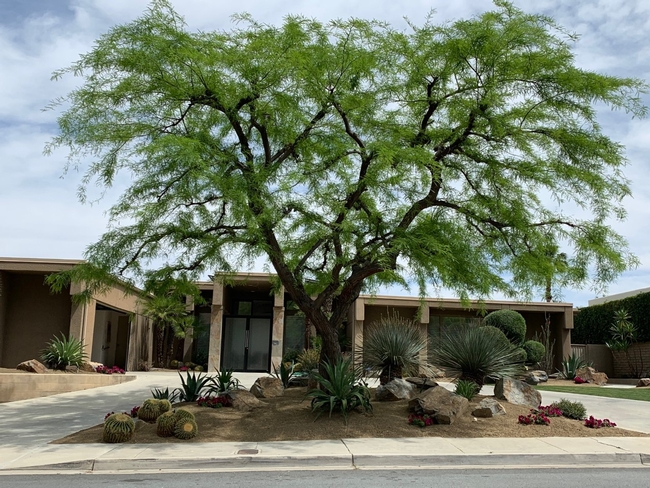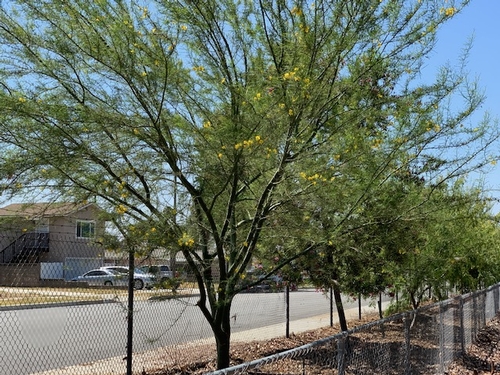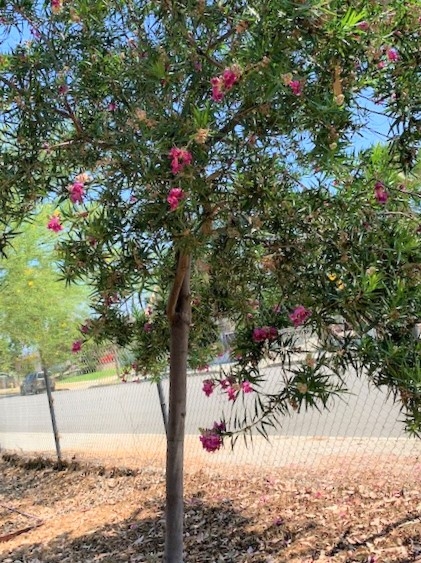Posts Tagged: conservation
Master Gardener Spotlight: Redlands Tree Canopy Enhancement Team
It's only right that our University of California Cooperative Extension (UCCE) San Bernardino County Master Gardener ‘Trees for Tomorrow' team of volunteers are our featured ‘Spotlight' Master Gardener volunteers for September, 2021. They provided vital education to Redlands residents receiving gratis trees through a multi-partnership grant obtained by Inland Empire Resource Conservation District Manager Mandy Parkes.
It's an honor and privilege to recognize UCCE San Bernardino County Master Gardener Project Leader Debbie LeDoux and her dedicated team of 'Trees for Tomorrow' volunteers: Zhibo (Sandy) Anderson; Consuelo (Connie) Davis (pictured); Pam O'Connell; Gail Sefl; and Husam Yousef. These dedicated Master Gardeners were tasked with helping residents select, plant and care for drought, heat, and pest tolerant trees. (Species including Chilopsis linearis 'Bubba', and Pistacia x 'Red Push' were selected due to their excellent performance in our University of California/United States Forest Service research project as 'climate-ready' trees able to withstand harsh conditions related to our changing climate.) Working with a team of California Climate Action Corps volunteers, civic leaders, Common Vision Coalition, and other groups, nearly 100 trees were planted in yards and parks lacking the preferred 25% tree canopy cover.
Trees can cool urban heat islands by 50 degrees Fahrenheit or more during spring and summer, creating welcome oases in hot inland communities. With spring 2021 temperatures so high they broke previous records on multiple dates, the project is especially timely and necessary.
In addition to proper tree selection, trees require the right long-term care. Master Gardeners will continue to provide advice on irrigation, pruning, fertilizing and pest control to residents receiving trees long after the trees are planted. This is critical since an average urban tree lives less than 20% of its potential lifespan due largely to poor care. The long-term engagement of Master Gardeners with residents is as important as is selecting the right species.
UCCE Master Gardeners are all volunteers, giving of their time and talents to enhance the quality of life for individuals and families who call San Bernardino County their home. Each Master Gardener is required to complete a rigorous 18-week training class complete with exams, class projects, and lots of participation! Due to COVID-19, volunteers had to master key horticultural concepts during the first ever all on-line training class. Only recently have they been able to meet fellow Master Gardener graduates and, in some cases, the Redlands residents they mentored through the tree canopy enhancement project. They truly exemplify community spirit and all it takes to successfully work together under adverse conditions. Kudos to each and every one of you from Master Gardener Coordinator Maggie O'Neil and myself! You are creating a cooler, greener and healthier environment for our children's children.
I asked the honored Master Gardeners their thoughts on the project. Here's what they had to say:
“The Redlands tree canopy project was the best volunteer project ever. In the midst of Covid-19, horrific politics and way too many good byes, it was a truly joyous experience. The legacy of being a part of the group that promoted healthy sustainable trees, knowledge of how to plant and care for them, tips on maintaining their health and beauty was the absolute best. For me as a Master Gardener, it was so much fun. I loved the site walks and getting to help our participants select the perfect sustainable trees for their properties. What started as a one-on-one visit often expanded to an enlarged group of neighbors and extended family. I got to give out many handouts and publications and promote our excellent Master Gardener program. I got to share our helpline email and phone numbers. I love the fact that I have been asked to revisit sites to see how great they are doing (once to make sure the tree did not look funny!). I receive emails every now and then asking me questions and showing me pictures of "Our Trees.” So much fun, Janet. Thank you. By far the coolest project ever! Pam O'Connell
------------------------------------------------------------------------------------------------------------------
There are a few things that really made an impact on me.1) It was rewarding to attend the Zoom presentation you developed that provided education to various professionals on the importance of planting sustainable trees. I found it to be open and inclusive allowing for good interchange of ideas and concerns.2) There are many beautiful trees that are sustainable.3) Reaching out to the community to offer beautiful, sustainable trees was a worthwhile way to show how various organizations can work together to benefit the community while trying to improve our environment.4) When dealing with homeowners that belong to an HOA, additional time and communication may be needed to assist them in obtaining approval for trees from their HOA's. Connie Davis
-----------------------------------------------------------------------------------------------------------------
"I see tree planting efforts similar to what a trend of the future is to combat climate change and increase awareness of the importance of trees and tree canopies in our neighborhoods. Not only that but I see this project expanded to other cities in the county of San Bernardino. The continuity of this project is so valuable so that we can see the positive impact on the environment and the well-being of San Bernardino residents in the coming decades. I see this important work being organized and well-coordinated by involving the appropriate stakeholders at all stages of the planning project. It is about time to give back what we have taken for tens of years!" Husam Yousef
------------------------------------------------
It was rewarding to see local homeowners excited about planting trees and grateful for the program providing them. Gail Sefl
---------------------------------------------
THANK YOU ALL! Janet Hartin and Maggie O'Neill
Trees Come First During the Drought!
During the drought, your trees should come first! Because many well-maintained trees don't reach their prime until their 4th or 5th decade, it's important to keep them watered during the drought and water restrictions. Older trees absorb higher levels of carbon dioxide, do a better job of cooling urban heat islands and providing shade. They also filter air and water pollutants, reduce soil and water erosion, provide habitat for wildlife, enhance privacy, beautify neighborhoods and parks, enhance property values, and even improve mental and emotional health. Trees are worth saving! The price of starting over is just too steep.
Recognizing early signs of drought stress is important because irreversible damage can occur that no amount of watering will correct. If you cash in your grass for a water district rebate, remember to water any trees that relied on water from the lawn sprinklers. This is because tree roots grow laterally quite a distance, often well beyond the dripline of the tree under the lawn. Over time, start watering them more deeply and less often to encourage deeper roots and enhanced stability.
Just a few deep waterings in mornings or late evenings with a garden hose during spring and summer can keep a tree alive, even during a drought. Keep the trunk dry and water from the mid-dripline outward. Apply a slow steady stream of water, moving the hose to another section of the tree every 1-2 hours. Another inexpensive way to water your trees is to encircle them with soaker hoses that connect to a garden hose. The soaker hose should be in concentric rings about one foot apart starting two feet away from the trunk for a larger tree, closer for a more recently planted tree with a more confined root system.
Check trees regularly for these common symptoms of water stress:
• Wilting or drooping leaves that don't return to normal by evening
• Yellow, brown or sometimes gray leaves that may drop from the tree
• Small new foliage and stunted overall tree growth
Other ways to reduce tree water loss include:
• Keep weeds out (they compete for water
• Maintain a 3-4” of organic mulch or 2” layer of inorganic mulch (pebbles, decomposed gravel) around your trees, starting a few inches away from the trunk outward.
• Avoid fertilizing since that increases their water need.
• Do only necessary pruning (to remove dead wood and any dangerous limbs that look like they might fail) since this stresses the tree and can increase its water need.
--------------------------------------------
UC Resources at Your Fingertips:
Free Download Publications: https://anrcatalog.ucanr.edu
-Keeping Plants Alive Under Drought and Water Restrictions
-Sustainable Landscaping in California
-Lawn Watering Guide for California
-Use of Graywater in CA Landscapes -
CA Institute for Water Resources: http://ciwr.ucanr.edu/ (blogs, climate-smart ag, podcasts, etc.)
UC Cooperative Extension Master Gardener Program:
For more drought tips and help with your home gardening questions, contact a UCCE Master Gardener volunteer. Find your local program atucanr.edu/FindUs/
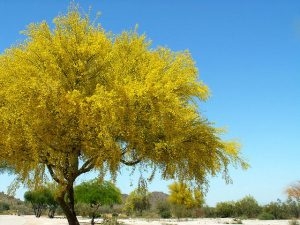
Palo Verde
Applications of Organic Mulch Result in Enhanced Tree Growth and Water Savings
I hope all of you and your loved ones are staying well and healthy as the pandemic continues. Involving yourself in outdoor activities is not only a great way to escape 'cabin fever' and improve your physical health but it is also good for you psychologically, as well.
A silver lining for me over the past few months has been the opportunity to summarize results of some research studies including an update from a mulch trial that I'll report on virtually rather than live at the American Society for Horticultural Science conference (that was to be held in Orlando). I thought you might be interested in the results.
The objective of the research project was to measure the impacts of organic mulch treatments on the growth and health of four species of low maintenance, drought-tolerant landscape trees under deficit irrigation. Species selected were Parkinsonia x ‘Desert Museum' (it's thornless!); Chilopsis linearis ‘Bubba' (Desert Willow) (beautiful magenta flowers!), Pistacia ‘Red Push' (hybrid from P. atlantica and P. integerrima with brilliant orange fall foliage), and Prosopis glandulosa ‘Maverick' (thornless). Trees were planted in a randomized complete block experimental design in at the Chino Basin Water Conservation District (CBWCD) in Montclair in October, 2016. Half of the trees received 4” of organic mulch and half did not. Trees were transplanted from 15-gallon containers and irrigated with recycled water at 80 percent of reference evapotranspiration (ETo) the first 12 months.
Irrigation was reduced to 50% ETo in November, 2017 which was maintained until May 2020, when irrigation ceased. While the study continues through October 2020, there are some interesting early results. Organic mulch applications enhanced growth with no loss in quality in the Pistacia, Prosopis glandulosa, and Chilopsis linearis trees while growth was actually better in the Parkinsonia trees that did not receive mulch. This may be due to the fact that its trunk and branches actively photosynthesize as well as its leaves. Parkinsonia leaves also feature sunken guard cells, providing another form of drought avoidance. Furthermore, they develop deep root systems and may not need the added benefit of reduced soil evaporation in the top few inches of soil provided by the mulch. While all of the species selected have wonderful attributes, the Parkinsonia 'Desert Museum' has all the best traits of its palo verde heritage including having no thorns and a continues bloom throughout summer.
A huge thanks to our UCCE San Bernardino County Master Gardener team (led by Irene) who take data quarterly on the trees, recording trunk circumference at 6" and 3'. This is another great example of the breadth and depth of the contributions of our wonderful volunteers!
The four species of landscape trees in this study are part of a larger study at University of California, Riverside to determine the ability of 12 species of landscape trees to mitigate impacts of climate change. While I'll be long retired, growth and health data of all species will continue to be evaluated through at least 2035. The study at CBWCD provided the opportunity for a mulch/no mulch treatment for four of the most promising species which was space-limited at UCR.
Below are plot photos from October 2016 (right after planting), July 2020 (no irrigation for 3 months), a mature 'Desert Museum' tree in prolific bloom (photo credit to Dr. Bob Perry, Emeritus Professor, Cal Poly Pomona), and a mature Chilopsis linearis 'Bubba' from our UCR plot.
Save the date! We will be hosting a virtual UCR Field Day on September 3, 2020 featuring our drought-tolerant landscape plots at UC Riverside that was to be held live last May. More information is forthcoming but it will provide at least four hours of continuing education hours and a chance for you to ask questions of Dr's Amir Haghverdi, Don Merhaut and myself.
Have a wonderful August in your garden!
Janet
Sensors, drones, and CIMIS: UCCE Partners with EarthWatch and CBWCD to Save Water in Urban Landscapes
On Friday UCCE San Bernardino County Master Gardener Coordinator Maggie O'Neill and I hosted a tour that showcased UC ANR Urban Water Use Specialist's Amir Haghverdi's landscape plots at the UCR Citrus Experiment Station. In attendance were CEO Scott Kania and Lead Scientist Mark Chandler from EarthWatch, Becky Rittenburg and Monica Curiel from Chino Basin Water Conservation District, and Darrel Jenerette, UC Riverside Professor of Landscape Ecology. Our team is implementing an exciting citizen science project measuring water conservation based on implementing 'best practices' in urban landscapes in the greater Los Angeles Basin.
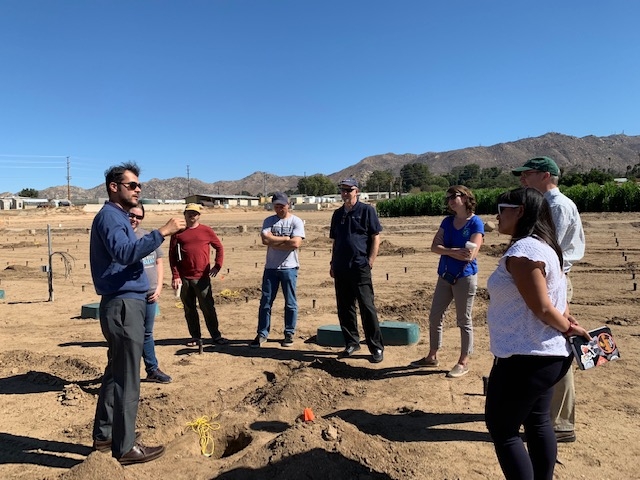
Amir Haghverdi showing plots to EarthWatch, UCCE and CBWCD teams
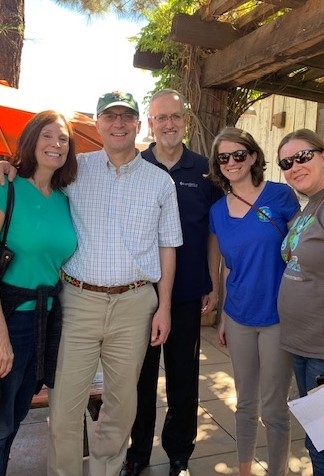
EarthWatch, CBWCD, and UCCE San Bernardino team





